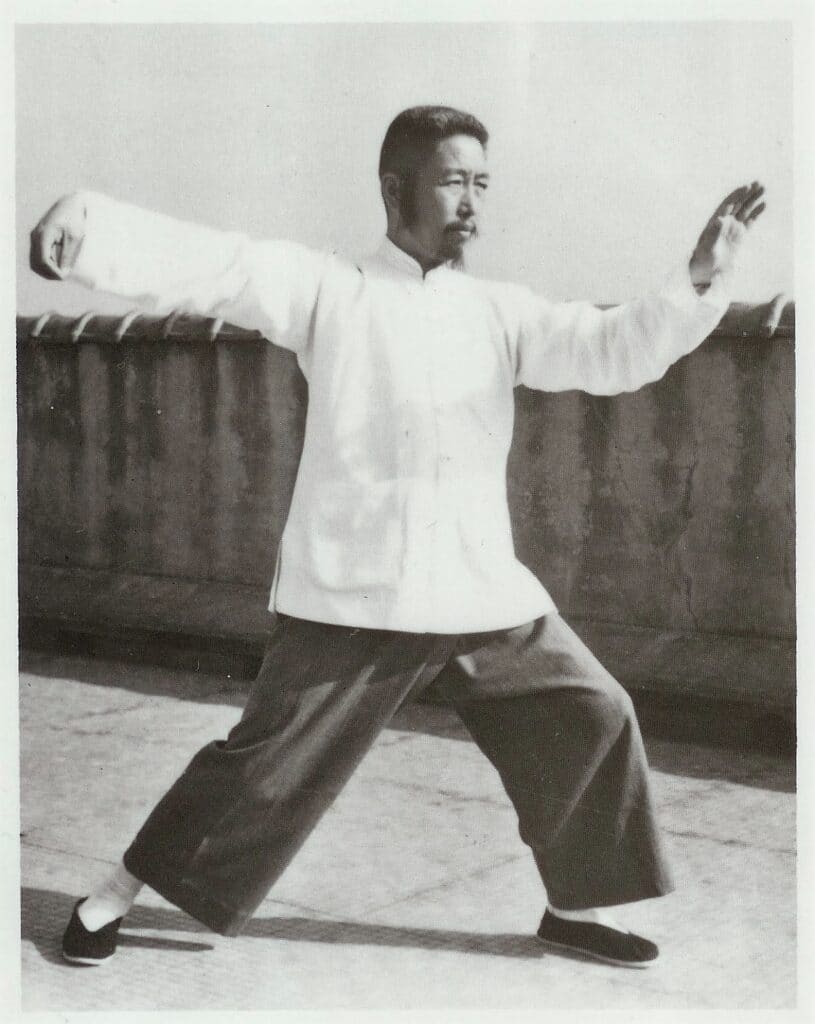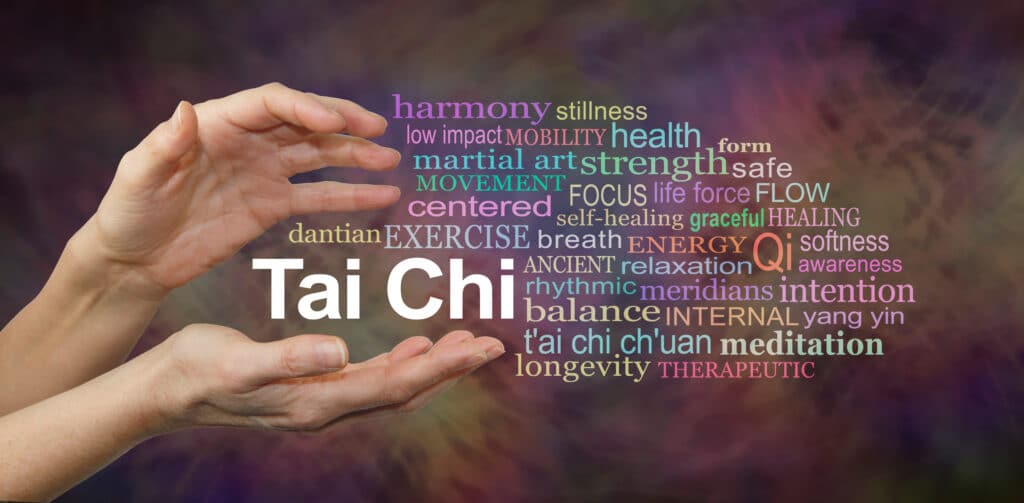
The Tai Chi 8 Form is based on the Yang Style Long Form, which is a more traditional style that uses 108 postures and generally takes about 20 minutes to perform.
Originally, the Yang Style Long Form was studied by Professor Cheng Man-Ching, a member of the famous Yang Family.
He was granted special permission to shorten it in order to teach it to the Chinese military during World War II. By shortening the form, the Yang style was simplified while retaining its essence.
Tai Chi Short Form 37 Postures
The Yang Style has many variations. The Cheng Man Ching (CMC) form has 37 variations, with slightly different movements and repetitions.
The Tai Chi 8 form has kicks and is a good starter form for beginners. Advanced students can progress to the 24 Simplified Form.
While the short form has many different names, they are all based on the Yang style. Here’s a look at some of the variations.
Tai Chi 8 Form Names And Health Benefits
| Posture | Movement and reps | Health Benefits |
| Commencing form: Lift hands | Both hands rise to shoulder level Center | Benefits the liver. |
| Repulse Monkey | Right then left; | Benefits the small and large intestines, gallbladder, kidneys and spinal cord. |
| Brush Knees Left, Twist Steps, Brush Knees Right | Left then Right | Benefits the heart, lower digestive tract and stomach disorders. |
| Twist Step, Part the Wild Horses Mane with Twist | Left then Right | Benefits the small and large intestines, gallbladder, stomach and lungs. |
| Move Hands Like Clouds | Left side leads; two times, then right 2 times | Benefits the large intestine, pancreas, spleen and stomach. |
| Golden Cock Stands on One Leg | Right leg up left down, then left leg up right down | Benefits the stomach. |
| Cross hands and heel kick | Kick right, then kick left | Benefits the kidneys and stomach. |
| Grasp Peacock’s Tail: Ward-off, Pull back, Press, Push | Right, then left | Benefit the large intestine; they also treat constipation. |
| Cross Hands Embrace the Tiger | Wide horse stance, Right leg comes in, Hand circle wide, and cross at the face right hand in front of left. | Benefits gastric-intestinal functions. |
| Closing form | Both hands fall to the side, left leg drawn to the right | Benefits gastric problems. |
Another Variation Of The Tai Chi Short Form
The Standard Simplified 24 Taijiquan Form was developed by the Chinese Sports Commission in 1956. It is the oldest form of the Yang Style and can be performed by students of all ages.
Short forms often have straight-line movement choreography and are less physically demanding than other Tai Chi styles.
The Tai Chi 8 form is also a great introduction to the long form of the Yang Family. It exemplifies the grace and beauty of the Tai Chi Chuan system.
There are many variations of the Yang style. The Tai Chi 8 form is just one of them. Some people consider the Chen style to be the oldest, but Chen Wangting is considered the original inventor.
Chen Wangting, who was the creator of the Yang style, is believed to have been 1580-1660. While he was not a member of the Chen family, he was considered the inventor of Tai Chi Chuan. This type of Tai Chi is also considered to be the most widely practiced.
The Grasping of the Sparrow’s Tail is part of the Four Gates of Taijiquan. In Chen Style, the grasping is done with the right hand while the Yang style uses the left hand.
The four gates of Taijiquan are based on the Yang Style and are more reserved and restrained. These two styles of Taijiquan are very different, but they have the same basic movements.
Tai Chi Long Form

There are some important differences between the Yang style and the Chuan Style of Tai Chi. Prof. Cheng shortened the Yang style, eliminating seventeen of its postures.
It is this short form that is taught in the United States today. Its name derives from the family that originally taught it. It was later shortened by Cheng Man-ch’ing.
The difference between the two forms is in the foot positions. For example, the Yang style has the front foot at 45 degrees to the forward direction, while the C.M.C. style requires the feet to be parallel.
The purpose of stepping with feet parallel is to open both sides of the body equally. This is illustrated in a model skeleton. The C.M.C. form is similar but uses the rear foot at the end of the movement.
The Yang style is the most common and widely practiced form of Tai Chi. It is also the most visually pleasing to watch because it uses more balance than any other style.
This style moves from right to left more often than the other styles, and it doesn’t rely on the dominant side. However, it is important to remember that the Yang style is shorter than the Cheng Manchings 37 form. Therefore, it is necessary to learn both styles of Tai Chi.
The Yang style has more movements than the C.M.C. style. For example, in the Yang form, the left-hand makes a large clockwise circle past the face.
In contrast, the C.M.C. style has an additional movement, called “Cloud Hands,” which is only performed twice. The difference between the two styles is significant when comparing the two styles.
There are many similarities and differences between the two styles, but the Yang style is the preferred style in the United States.
The traditional Yang style is a slow form with sweeping movements and gentleness. It is suited to a wide age range.
In addition, it is also a versatile form that is suitable for people of all fitness levels and ages. As long as you can follow the instructions, you can expect to get a great workout while improving your health and well-being. When you learn this form, you can concentrate on the internal aspects of the form to enhance its overall health.
Tai Chi Exercises
There are several types of Tai Chi Exercises for Yang Style practitioners. One of these exercises is the tuishou. This is a core training exercise.
The number of moves in the form varies from 85 to 108. Although there are many variations like the Tai Chi 8 form, there are some key differences.
Here are a few benefits of practicing taichi exercises for the Yang style. They will help you improve your form and improve your strength.
Another benefit to practicing tai chi is that it is low-impact, putting minimal stress on your muscles and joints.
It is safe for people of all ages and fitness levels and is especially suitable for older adults. There is also no need for expensive equipment or studio memberships, and you can practice at home, at the office, or in a group class.
As long as you know what you’re doing, you’re sure to reap the benefits of this form of exercise.
Tai Chi exercises for older adults should be modified to suit their physical limitations. Many individuals of similar biological age can respond differently to Tai-Chi exercises.
Because of this, programs should be customized according to the functional ability of each practitioner. Older adults may find traditional Tai-Chi sequences difficult to perform.
In such cases, individualized Tai-Chi exercises can maximize their benefits and improve adherence to the exercises.
The traditional Yang style of tai chi involves 108 movements. Each movement requires an intense focus of the practitioner’s body and mind.
Yang Tai Chi is challenging but can be practiced safely by individuals of all ages and physical fitness levels. Yang-style tai chi is a great way to stay fit and healthy! The Tai Chi 8 form for beginners is a great place to start.
And with the right practice, you’ll be on your way to a healthier and happier you.
What Is Ngo Dac Na Tai Chi?
We only practice the Yang Style Tai Chi Long Form. The reasoning is that if you really want to get all health benefits to their maximum. Doing the long-form is the way to go. If you want to include Tai Chi in your fighting tool belt learning the long form would be most beneficial.
When Sifu Phu taught me the Tai Chi Chuan Long Form I noticed while it looked similar to the other yang forms it also looked slightly different.
Now that I have been doing the form for many years I would say that everyone’s form is slightly different since we are all built differently.
The real difference though is our energy projection and placement. We apply the Ngo Dac Na principles to our Tai Chi. It becomes very noticeable in the Tai Chi Push Hands Game.

[…] the philosophy, theory, and practice of Tai Chi. In this article, we will take a deeper look at the Tai Chi Classics and explore their historical background, interpretation and translation, and the role of postures […]